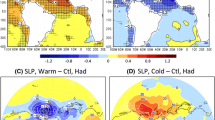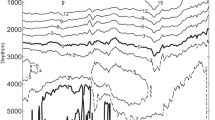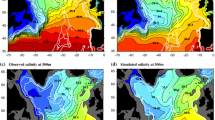Abstract
The NCEP twentieth century reanalyis and a 500-year control simulation with the IPSL-CM5 climate model are used to assess the influence of ocean-atmosphere coupling in the North Atlantic region at seasonal to decadal time scales. At the seasonal scale, the air-sea interaction patterns are similar in the model and observations. In both, a statistically significant summer sea surface temperature (SST) anomaly with a horseshoe shape leads an atmospheric signal that resembles the North Atlantic Oscillation (NAO) during the winter. The air-sea interactions in the model thus seem realistic, although the amplitude of the atmospheric signal is half that observed, and it is detected throughout the cold season, while it is significant only in late fall and early winter in the observations. In both model and observations, the North Atlantic horseshoe SST anomaly pattern is in part generated by the spring and summer internal atmospheric variability. In the model, the influence of the ocean dynamics can be assessed and is found to contribute to the SST anomaly, in particular at the decadal scale. Indeed, the North Atlantic SST anomalies that follow an intensification of the Atlantic meridional overturning circulation (AMOC) by about 9 years, or an intensification of a clockwise intergyre gyre in the Atlantic Ocean by 6 years, resemble the horseshoe pattern, and are also similar to the model Atlantic Multidecadal Oscillation (AMO). As the AMOC is shown to have a significant impact on the winter NAO, most strongly when it leads by 9 years, the decadal interactions in the model are consistent with the seasonal analysis. In the observations, there is also a strong correlation between the AMO and the SST horseshoe pattern that influences the NAO. The analogy with the coupled model suggests that the natural variability of the AMOC and the gyre circulation might influence the climate of the North Atlantic region at the decadal scale.













Similar content being viewed by others
References
Alexander M, Scott J (2002) The influence of ENSO on air-sea interaction in the Atlantic. Geophys Res Lett 29(14):46. doi:10.1029/2001GL014347
Barston AG, Lizevey RE (1987) Classification, seasonality and persistence of low-frequency atmospheric circulation patterns. Mon Wea Rev 115:1083–1126
Bellucci A, Gualdi S, Scoccimarro E, Navarra A (2008) NAO-ocean circulation interactions in a coupled general circulation model. Clim Dyn 31(7):759–777
Bretherton C, Widmann M, Dymnikov V, Wallace J, Bladé I (1999) The effective number of spatial degrees of freedom of a time-varying field. J Climate 12(7):1990–2009
Bretherton CS, Smith C, Wallace JM (1992) An intercomparison of methods for finding coupled patterns in climate data. J Climate 5(6):541–560
Cassou C, Deser C, Alexander MA (2007) Investigating the impact of reemerging sea surface temperature anomalies on the winter atmospheric circulation over the North Atlantic. J Climate 20(14):3510–3526
Cayan DR (1992) Latent and sensible heat flux anomalies over the northern oceans: the connection to monthly atmospheric circulation. J Climate 5(4):354–369
Chelton D, Xie S-P (2010) Coupled ocean-atmosphere interaction at oceanic mesoscales. Oceanography 23(4):52–69
Collins M et al (2006) Interannual to decadal climate predictability in the North Atlantic: a multimodel-ensemble study. J Climate 19(7):1195–1203
Compo GP, Sardeshmukh PD (2010) Removing ENSO-related variations from the climate record. J Climate 23(8):1957–1978
Compo GP et al (2011) The twentieth century reanalysis project. Q J R Meteorol Soc 137(654):1–28
Cunningham SA et al (2007) Temporal variability of the Atlantic meridional overturning circulation at 26.5N. Science 317(5840):935–938
Czaja A, Frankignoul C (1999) Influence of the North Atlantic SST on the atmospheric circulation. Geophys Res Lett 26:2969–2972
Czaja A, Frankignoul C (2002) Observed impact of Atlantic SST anomalies on the North Atlantic oscillation. J Climate 15(6):606–623
Czaja A, Marshall J (2001) Observations of atmosphere-ocean coupling in the North Atlantic. Q J R Meteorol Soc 127:1893–1916
Czaja A, van der Vaart P, Marshall J (2002) A diagnostic study of the role of remote forcing in tropical Atlantic variability. J Climate 15(22):3280–3290
Danabasoglu G (2008) On multidecadal variability of the Atlantic meridional overturning circulation in the community climate system model version 3. J Climate 21(21):5524–5544
D’Andrea F, Czaja A, Marshall J (2005) Impact of anomalous ocean heat transport on the North Atlantic oscillation. J Climate 18(23):4955–4969
Delworth TL, Greatbatch RJ (2000) Multidecadal thermohaline circulation variability driven by atmospheric surface flux forcing. J Climate 13(9):1481–1495
Deser C, Alexander MA, Xie S, Phillips AS (2009) Sea surface temperature variability: patterns and mechanisms. Annu Rev Marine Sci 2(1):115–143
Deser C, Tomas RA, Peng S (2007) The transient atmospheric circulation response to North Atlantic SST and sea ice anomalies. J Climate 20(18):4751–4767
Deshayes J, Frankignoul C (2008) Simulated variability of the circulation in the North Atlantic from 1953 to 2003. J Climate 21(19):4919–4933
Dong B, Sutton RT, Scaife AA (2006) Multidecadal modulation of El Niño Southern Oscillation (ENSO) variance by Atlantic Ocean sea surface temperatures. Geophys Res Lett 33(8):L08 705. doi:10.1029/2006GL025766
Eden C, Greatbatch RJ (2003) A damped decadal oscillation in the North Atlantic climate system. J Climate 16(24):4043–4060
Eden C, Willebrand J (2001) of interannual to decadal variability of the North Atlantic circulation. J Climate 14(10):2266–2280
Enfield DB, Cid-Serrano L (2010) Secular and multidecadal warmings in the North Atlantic and their relationships with major hurricane activity. Int J Climatol 30(2):174–184
Feldstein SB (2000) The timescale, power spectra, and climate noise properties of teleconnection patterns. J Climate 13(24):4430–4440
Folland CK, Knight J, Linderholm HW, Fereday D, Ineson S, Hurrell JW (2009) The summer North Atlantic oscillation: past, present, and future. J Climate 22(5):1082–1103
Frankignoul C, Chouaib N, Liu Z (2011) Estimating the observed atmospheric response to SST anomalies: maximum covariance analysis, generalized equilibrium feedback assessment, and maximum response estimation. J Climate 24(10):2523–2539. doi:10.1175/2010JCLI3696.1
Frankignoul C, Hasselmann K (1977) Stochastic climate models. Part II: application to sea-surface temperature anomalies and thermocline variability. Tellus 29(4):289–305
Frankignoul C, Kestenare E (2002) The surface heat flux feedback. Part I: estimates from observations in the Atlantic and the North Pacific. Clim Dyn 19:633–647
Frankignoul C, Kestenare E (2005) Air-sea interactions in the tropical Atlantic: a view based on lagged rotated maximum covariance analysis. J Climate 18(18):3874–3890
Gastineau G, Frankignoul C (2011) Cold-season atmospheric response to the natural variability of the Atlantic meridional overturning circulation. Clim Dyn, in press, 1–21. doi:10.1007/s00382-011-1109-y
Gray ST, Graumlich LJ, Betancourt JL, Pederson GT (2004) A tree-ring based reconstruction of the Atlantic multidecadal oscillation since 1567 AD. Geophys Res Lett 31(12):L12 205. doi:10.1029/2004GL019932
Guan B, Nigam S (2009) Analysis of Atlantic SST variability factoring interbasin links and the secular trend: clarified structure of the Atlantic multidecadal oscillation. J Climate 22(15):4228–4240
Guemas V, Codron F (2011) Differing impacts of resolution changes in latitude and longitude on the midlatitudes in the LMDZ atmospheric GCM. J Climate 24(22):5831–5849
Hodson D, Sutton R, Cassou C, Keenlyside N, Okumura Y, Zhou T (2010) Climate impacts of recent multidecadal changes in Atlantic Ocean sea surface temperature: a multimodel comparison. Clim Dyn 34:1041–1058
Hurrell J, Kushnir Y, Visbeck M, Ottersen G (2003) An overview of the North Atlantic oscillation. The North Atlantic oscillation, climatic significance and environmental impact. AGU Geophys Monogr 134:1–35
Keenlyside N, Latif M, Jungclaus J, Kornblueh L, Roeckner E (2008) Advancing decadal-scale climate prediction in the North Atlantic sector. Nature 453:84–88
Knight J, Allan R, Folland C, Vellinga M, Mann M (2005) A signature of persistent natural thermohaline circulation cycles in observed climate. Geophys Res Lett 32:L20 708. doi:1029/2005GL024 233
Krinner G et al (2005) A dynamic global vegetation model for studies of the coupled atmosphere-biosphere system. Global Biogeochem Cycles 19(1):GB1015. doi:10.1029/2003GB002199
Kushnir Y (1994) Interdecadal variations in North Atlantic sea surface temperature and associated atmospheric conditions. J Climate 7(1):141–157
Madec G (2008) NEMO ocean engine. Tech. rep., Note du Pole de modelisation, Institut Pierre-Simon Laplace (IPSL) No 27
Magnusdottir G, Deser C, Saravanan R (2004) The effects of North Atlantic SST and sea ice anomalies on the winter circulation in CCM3. Part I: main features and storm track characteristics of the response. J Climate 17(5):857–876
Mann ME, Bradley RS, Hughes MK (1998) Global-scale temperature patterns and climate forcing over the past six centuries. Nature 392(6678):779–787
Marini C (2011) On the causes and effects of the Atlantic Meridional Overturning Circulation. Ph.D. dissertation, LOCEAN-IPSL, Université Pierre et Marie Curie
Marshall J, Johnson H, Goodman J (2001) A study of the interaction of the North Atlantic oscillation with ocean circulation. J Climate 14(7):1399–1421
Maury P, Lott F, Guez L, Duvel J-P (2012) Tropical variability and stratospheric equatorial waves in the IPSLCM5 model. Clim Dyn. doi:10.1007/s00382-011-1273-0
Medhaug I, Furevik T (2011) North Atlantic 20th century multidecadal variability in coupled climate models: sea surface temperature and ocean overturning circulation. Ocean Sci 7:389–404. doi:10.5194/os-7-389-2011
Msadek R, Frankignoul C (2009) Atlantic multidecadal oceanic variability and its influence on the atmosphere in a climate model. Clim Dyn 33:45–62
Munoz E, Kirtman B, Weijer W (2011) Varied representation of the Atlantic meridional overturning across multidecadal ocean reanalyses. Deep Sea Res II 58(17–18):1848–1857
OrtizBeviá MJ, Pérez-González I, Alvarez-García FJ, Gershunov A (2010) Nonlinear estimation of El Niño impact on the North Atlantic winter. J Geophys Res 115:D21 123. doi:10.1029/2009JD013387
Park S, Deser C, Alexander MA (2005) Estimation of the surface heat flux response to sea surface temperature anomalies over the global oceans. J Climate 18(21):4582–4599
Peng S, Robinson WA, Li S (2002) North Atlantic SST forcing of the NAO and relationships with intrinsic hemispheric variability. Geophys Res Lett 29(8):1276. doi:10.1029/2001GL014043
Peng S, Robinson WA, Li S (2003) Mechanisms for the NAO responses to the North Atlantic SST tripole. J Climate 16(12):1987–2004
Peng S, Whitaker JS (1999) Mechanisms determining the atmospheric response to midlatitude SST anomalies. J Climate 12(5):1393–1408
Penland C, Matrosova L (2006) Studies of El Niño and interdecadal variability in tropical sea surface temperatures using a nonnormal filter. J Climate 19(22):5796–5815
Pohlmann H, Sienz F, Latif M (2006) Influence of the multidecadal Atlantic meridional overturning circulation variability on European climate. J Climate 19(23):6062–6067
Quadrelli R, Wallace JM (2004) A simplified linear framework for interpreting patterns of northern hemisphere wintertime climate variability. J Climate 17(19):3728–3744
Rayner NA, Parker DE, Horton EB, Folland CK, Alexander LV, Rowell DP, Kent EC, Kaplan A (2003) Global analyses of sea surface temperature, sea ice, and night marine air temperature since the late nineteenth century. J Geophys Res 108(D14):4407. doi:10.1029/2002JD002670
Schneider EK, Fan M (2012) Observed decadal North Atlantic tripole SST variability. Part II: diagnosis of mechanisms. J Atmos Sci 69(1):51–64
Schott FA, Lee TN, Zantopp R (1988) Variability of structure and transport of the Florida current in the period range of days to seasonal. J Phys Oceanogr 18(9):1209–1230
Seager R, Harnik N, Kushnir Y, Robinson W, Miller J (2003) Mechanisms of hemispherically symmetric climate variability. J Climate 16:2960–2978
Stickler A et al (2009) The comprehensive historical upper-air network. Bull Am Meteorol Soc 91(6):741–751
Strong C, Magnusdottir G, Stern H (2009) Observed feedback between winter sea ice and the North Atlantic oscillation. J Climate 22(22):6021–6032
Sutton RT, Hodson DLR (2007) Climate response to basin-scale warming and cooling of the North Atlantic Ocean. J Climate 20(5):891–907
Sutton RW, Hodson DLR (2005) Atlantic Ocean forcing of North American and European summer climate. Science 309:115–118
Teng H, Branstator G, Meehl GA (2011) Predictability of the Atlantic overturning circulation and associated surface patterns in two CCSM3 climate change ensemble experiments. J Climate, in press, doi:10.1175/2011JCLI4207.1
Thompson D, Wallace J (1998) The Arctic oscillation signature in the wintertime geopotential height and temperature fields. Geophys Res Lett 25:1297–1300
Trenberth KE, Shea DJ (2006) Atlantic hurricanes and natural variability in 2005. Geophys Res Lett 33:L12 704. doi:10.1029/2006GL026 894
Valcke S (2006) OASIS3 User guide (prism 2-5). Tech. rep., CERFACS PRISM Support Initiative Report, No 3, p 64
Watanabe M, Kimoto M (2000) Atmosphere-ocean thermal coupling in the North Atlantic: a positive feedback. Q J R Meteorol Soc 126(570):3343–3369
Acknowledgments
The research leading to these results has received funding from the European Community’s 7th framework programme (FP7/2007-2013) under grant agreement No. GA212643 (THOR: “Thermohaline Overturning—at Risk”, 2008-2012). We are grateful to C. Marini who provided the HadISST-LIM data. We also thank J. Mignot, D. Swingedouw and two anonymous reviewers for their useful comments and suggestions.
Author information
Authors and Affiliations
Corresponding author
Additional information
This paper is a contribution to the special issue on the IPSL and CNRM global climate and Earth System Models, both developed in France and contributing to the 5th coupled model intercomparison project.
Appendix: The removal of ENSO from North Atlantic SST and geopotential height
Appendix: The removal of ENSO from North Atlantic SST and geopotential height
The variability of ENSO is assessed using the first two PCs of the SST in the equatorial Pacific Ocean (12.5°S–12.5°N, 100°E–80°W). The first (second) modes represent between 62 and 66 % (7 and 11 %) of the total variance depending on the season. The ENSO variability is rather low in IPSL-CM5, with an incorrect phase locking of the ENSO variability to the annual cycle, even if its frequency spectrum is relatively similar to that of the observations.
Here, the relations between ENSO and the North Atlantic variability are assessed using simultaneous regressions of the SST (K) and Z500 (m) onto the first normalized PC of the Equatorial Pacific SST. In observations (Fig. 14), the main ENSO effect is to shift the subtropical jets equatorwards during El Niño phase, thereby inducing the same SST anomalies as a negative NAO in the Atlantic subtropical domain (Seager et al. 2003), while the subpolar North Atlantic SST anomalies are much weaker and not significant. In IPSL-CM5 (Fig. 15), the subtropical SST anomalies in response to ENSO are weaker, which is consistent with an underestimation of the SST variability off the coast of Africa. A positive phase of ENSO (El Niño) also warms the subpolar gyre, and the overall SST pattern is similar to the SST tripole associated to a negative NAO. This is consistent with the AMO (see Fig. 5, lower panels), that shows a link between the North Atlantic subpolar region and the equatorial Pacific Ocean in IPSL-CM5, but not for HadISST-LIM. This might be related to the incorrect phase locking of ENSO, which was demonstrated to alter the teleconnection with the Equatorial Pacific.
Regression of the JFM (left panel) SST, in K, and (right panel) Z500, in m, onto the normalized ENSO index, in NCEP twentieth century and HadISST-LIM. The ENSO index is the PC1 of the JFM SST in the Equatorial Pacific. The color shades are suppressed when the significance, given by Monte Carlo analysis, is below 5 %
Same as Fig. 14, but for IPSL-CM5 during JFM
The winter Z500 related to ENSO SST anomalies has strong anomalies over North America, as the Pacific-North American pattern is strongly modulated by ENSO. Over the North Atlantic the Z500 anomalies are roughly similar to the NAO, an El Niño phase causing a negative phase of the NAO in both model and observation as in Alexander and Scott (2002). The anomalies are also similar to those of OrtizBeviá et al. (2010), but the strong non-linearity of the ENSO teleconnections is neglected in this study.
In both the model and observations, ENSO has an impact onto SST and Z500 similar to the local influence of SST anomalies (compare Figs. 14 and 15 with Figs. 3 and 4, for lags larger than 3–4 months). Unlike in the observations of Frankignoul and Kestenare (2005), the removal of ENSO turned out to reduce the statistical significance of squared covariance and correlation of the first MCA mode when the ocean leads compared to other studies Czaja and Frankignoul (1999); Czaja and Frankignoul (2002), where ENSO was not removed from the SST and Z500. For example, when ENSO is not removed in observations, the squared covariance of the first MCA mode is 5 % significant up to lag 6 months when the ocean leads for Z500 in FMA, while the statistical significance is similar for Z500 in NDJ.
Rights and permissions
About this article
Cite this article
Gastineau, G., D’Andrea, F. & Frankignoul, C. Atmospheric response to the North Atlantic Ocean variability on seasonal to decadal time scales. Clim Dyn 40, 2311–2330 (2013). https://doi.org/10.1007/s00382-012-1333-0
Received:
Accepted:
Published:
Issue Date:
DOI: https://doi.org/10.1007/s00382-012-1333-0






